System control MITSUBISHI ECLIPSE CROSS 2019 (in English) User Guide
[x] Cancel search | Manufacturer: MITSUBISHI, Model Year: 2019, Model line: ECLIPSE CROSS, Model: MITSUBISHI ECLIPSE CROSS 2019Pages: 423, PDF Size: 75.41 MB
Page 28 of 423

Telematics Control Unit (TCU) (if so equipped)
General information 3-7
3
1. After setting the operation mode to ON, the indicator lights (A) illuminate for approximately 10 seconds. When approxi-mately 10 seconds has elapsed after the lights extinguish, the system is in the standby state.
2. The system operates by the following.
[Automatic Report] If your vehicle's airbags deploy or if the unit detects that the vehicle was in a severe collision, your vehicle automati-cally will attempt to connect to the emer- gency call center operator. Once connected, information about your vehi-cle, its location, and its condition will be sent to the operator; you also can speak to the operator when connected.[Manual Report]When you open the cover (B) and press the SOS switch (C).
WA R N I N G Do not remove or modify the above parts. This can cause the system to not operate.NOTE
Although the information switch is not for use in emergencies, the operation is the same as the operation of the SOS switch for SOSemergency assist.WA R N I N G If the indicator lights do not illuminate after setting the operation mode to ON,there is a possible problem in the system. Have the system inspected by an autho- rized Mitsubishi Motors dealer or a repair facility of your choice.
If the indicator lights (A) remain illumi- nated or illuminate again after setting the operation mode to ON, there is a possible problem in the system or the battery for exclusive use of the TCU may beexhausted. The battery life is approxi- mately 3 years. Have the system inspected or replace thebattery using an authorized Mitsubishi Motors dealer or a repair facility of your choice. When the system is not in the standby state, the system does not operate. Whenyou drive, make sure to check that the sys- tem is in the standby state.NOTE
Even if the SOS emergency assist is in the standby state, communication may not bepossible for a while depending on the radio wave conditions.WA R N I N G
WA R N I N G Before pressing the SOS switch, stop the vehicle in a safe place. If you operate it while driving, your attention to the sur- rounding conditions may be affected,resulting in an accident.CAUTION Do not open the cover unless you intend to press the SOS switch. You may press the SOS switch by mistake. In addition, if the cover is left open while driving, the covercan cause injury in the event of an accident.
BK0266800US.bo
ok 7 ページ 2018年6月27日 水曜日 午後5時6分
Page 29 of 423

Telematics Control Unit (TCU) (if so equipped) 3-8 General information
3
3. The green indicator light blinks and the system calls the emergency call center. 4. The green indicator light blinks slowly, and the location and vehicle information is transmitted to the emergency call cen-ter. 5. When the green indicator light changes from a blinking state to an illuminationstate a conversation with an operator of the emergency call center is available.
6. The emergency call center arranges for dispatch of the emergency vehicle asrequired.
NOTE
Do not press the SOS switch unless there is an emergency such as an accident or sudden illness. If an emergency vehicle, etc. is dis- patched unnecessarily, you may be charged.WA R N I N G If the red indicator light illuminates as fol- lows, directly arrange an emergency vehi- cle or road service with a cellular phone,etc.• When the red indicator light remainsilluminated. (There is a possible problem in the system.)• When the red indicator light illuminatesfor 60 seconds. (The vehicle may be in the place where radio waves cannot betransmitted and received.)
WA R N I N G Do not replace the speakers. If they are replaced, the voice of the operator at the emergency call center may not be audible. If the speakers need to be replaced due to a problem, etc., we recommend you con-sult an authorized Mitsubishi Motors dealer or a repair facility of your choice. An error may occur between the actual report point and the point reported to the emergency call center. Mutually confirmthe report point and the object through the phone call with the operator of the emergency call center.NOTE
If the vehicle side microphone (E) and/or the speakers fail, you cannot talk with the opera- tor of the emergency call center. An emergency call cannot be disconnected from the vehicle side.
BK0266800US.bo
ok 8 ページ 2018年6月27日 水曜日 午後5時6分
Page 30 of 423
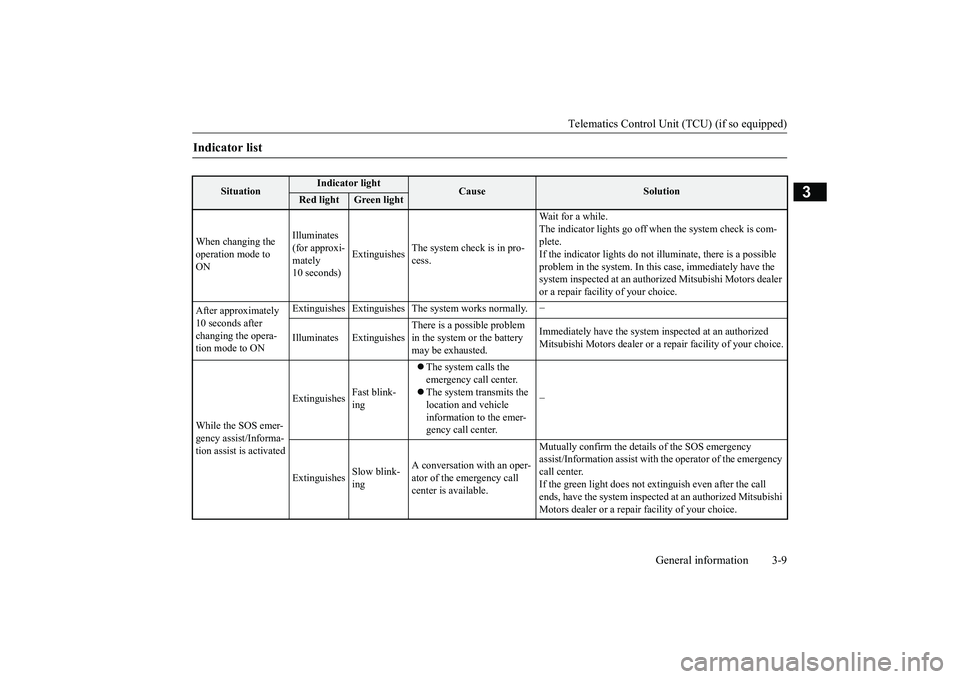
Telematics Control Unit (TCU) (if so equipped)
General information 3-9
3
Indicator list
Situation
Indicator light
Cause
Solution
Red light
Green light
When changing the operation mode to ON
Illuminates (for approxi- mately 10 seconds)
Extinguishes
The system check is in pro- cess.
Wait for a while. The indicator lights go off when the system check is com- plete. If the indicator lights do not illuminate, there is a possible problem in the system. In this case, immediately have the system inspected at an authorized Mitsubishi Motors dealer or a repair facility of your choice.
After approximately 10 seconds after changing the opera- tion mode to ON
Extinguishes Extinguishes The system works normally.
−
Illuminates Extinguishes
There is a possible problem in the system or the battery may be exhausted.
Immediately have the system inspected at an authorized Mitsubishi Motors dealer or a repair facility of your choice.
While the SOS emer- gency assist/Informa- tion assist is activated
Extinguishes
Fast blink- ing
The system calls the emergency call center. The system transmits the location and vehicle information to the emer-gency call center.
−
Extinguishes
Slow blink- ing
A conversation with an oper- ator of the emergency call center is available.
Mutually confirm the details of the SOS emergency assist/Information assist with the operator of the emergency call center.If the green light does not extinguish even after the call ends, have the system inspected
at an authorized Mitsubishi
Motors dealer or a repair facility of your choice.
BK0266800US.bo
ok 9 ページ 2018年6月27日 水曜日 午後5時6分
Page 31 of 423
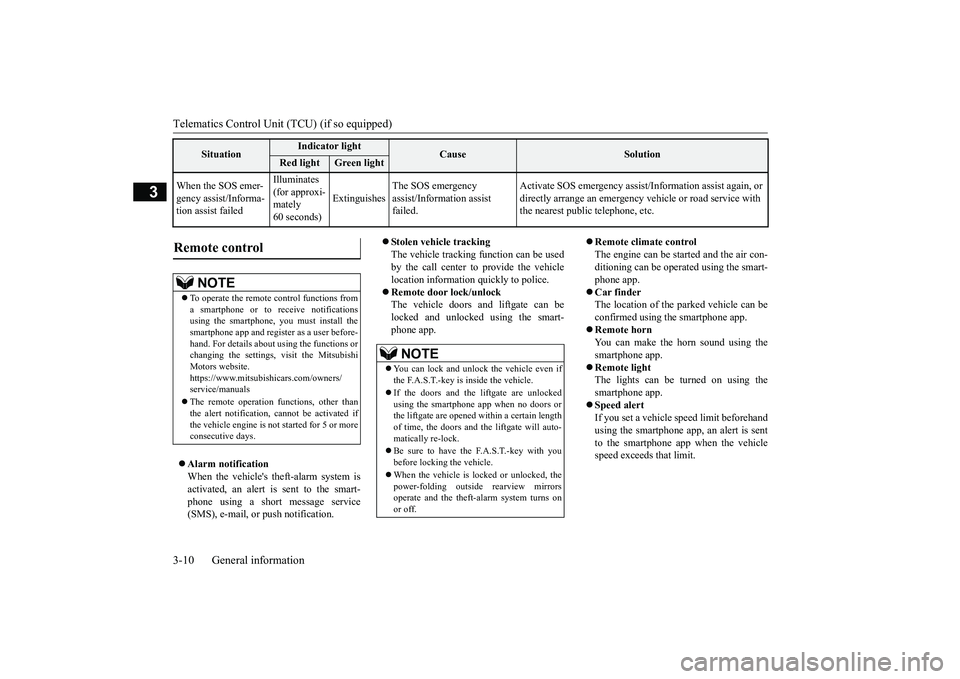
Telematics Control Unit (TCU) (if so equipped) 3-10 General information
3
Alarm notification When the vehicle's theft-alarm system is activated, an alert is sent to the smart- phone using a short message service(SMS), e-mail, or push notification.
Stolen vehicle tracking The vehicle tracking function can be usedby the call center to provide the vehicle location information quickly to police. Remote door lock/unlock The vehicle doors and liftgate can be locked and unlocked using the smart- phone app.
Remote climate control The engine can be started and the air con-ditioning can be operated using the smart- phone app. Car finder The location of the parked vehicle can be confirmed using the smartphone app. Remote horn You can make the horn sound using thesmartphone app. Remote light The lights can be turned on using thesmartphone app. Speed alert If you set a vehicle speed limit beforehandusing the smartphone app, an alert is sent to the smartphone app when the vehicle speed exceeds that limit.
When the SOS emer- gency assist/Informa- tion assist failed
Illuminates (for approxi-mately 60 seconds)
Extinguishes
The SOS emergency assist/Information assist failed.
Activate SOS emergency assist/I
nformation assist again, or
directly arrange an emergency
vehicle or road service with
the nearest public telephone, etc.
Situation
Indicator light
Cause
Solution
Red light
Green light
Remote control
NOTE
To operate the remote control functions from a smartphone or to receive notifications using the smartphone, you must install thesmartphone app and register as a user before- hand. For details about using the functions or changing the settings,
visit the Mitsubishi
Motors website. https://www.mitsubishicars.com/owners/ service/manuals The remote operation functions, other than the alert notification, cannot be activated ifthe vehicle engine is not started for 5 or more consecutive days.
NOTE
You can lock and unlock the vehicle even if the F.A.S.T.-key is inside the vehicle. If the doors and the liftgate are unlocked using the smartphone app when no doors or the liftgate are opened within a certain length of time, the doors and the liftgate will auto-matically re-lock. Be sure to have the F.A.S.T.-key with you before locking the vehicle. When the vehicle is locked or unlocked, the power-folding outside rearview mirrors operate and the theft-alarm system turns on or off.
BK0266800US.bo
ok 10 ページ 2018年6月27日 水曜日 午後5時6分
Page 32 of 423
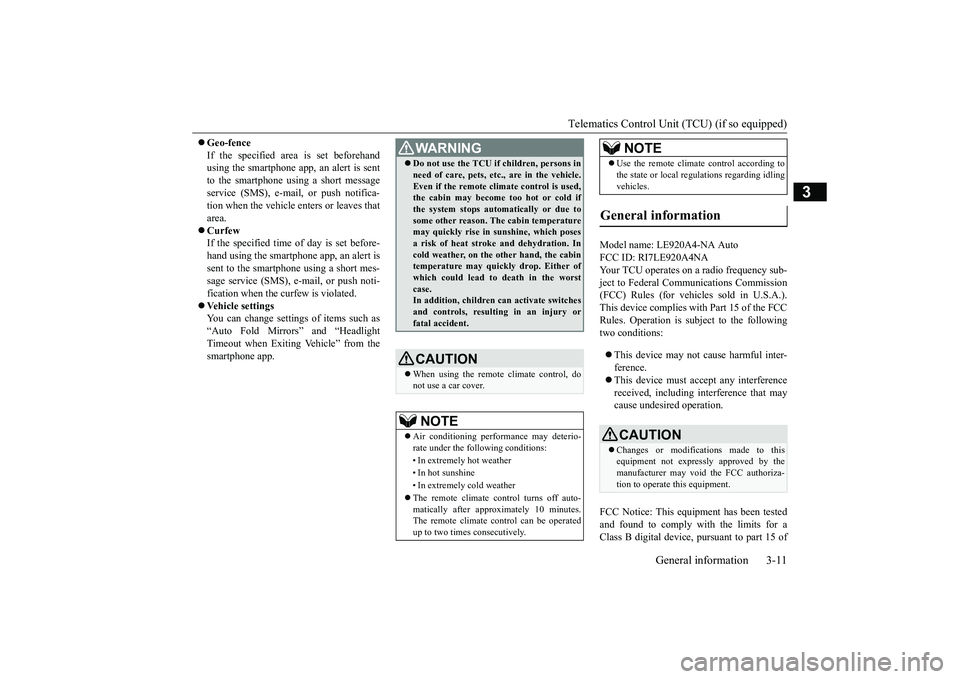
Telematics Control Unit (TCU) (if so equipped)
General information 3-11
3
Geo-fence If the specified area is set beforehand using the smartphone app, an alert is sent to the smartphone using a short messageservice (SMS), e-mail, or push notifica- tion when the vehicle enters or leaves that area. Curfew If the specified time of day is set before- hand using the smartphone app, an alert issent to the smartphone using a short mes-sage service (SMS), e-mail, or push noti- fication when the curfew is violated. Vehicle settings You can change settings of items such as “Auto Fold Mirrors” and “Headlight Timeout when Exiting Vehicle” from thesmartphone app.
Model name: LE920A4-NA Auto FCC ID: RI7LE920A4NAYour TCU operates on a radio frequency sub-ject to Federal Communications Commission (FCC) Rules (for vehicles sold in U.S.A.). This device complies with Part 15 of the FCCRules. Operation is subject to the following two conditions: This device may not cause harmful inter- ference. This device must accept any interference received, including interference that may cause undesired operation.
FCC Notice: This equipment has been tested and found to comply with the limits for a Class B digital device, pursuant to part 15 of
WA R N I N G Do not use the TCU if children, persons in need of care, pets, etc., are in the vehicle. Even if the remote climate control is used, the cabin may become too hot or cold if the system stops automatically or due tosome other reason. The cabin temperature may quickly rise in sunshine, which poses a risk of heat stroke and dehydration. Incold weather, on the other hand, the cabin temperature may quickly drop. Either of which could lead to death in the worstcase. In addition, children can activate switches and controls, resulting in an injury orfatal accident.CAUTION When using the remote climate control, do not use a car cover.NOTE
Air conditioning performance may deterio- rate under the following conditions: • In extremely hot weather • In hot sunshine • In extremely cold weather The remote climate control turns off auto- matically after approximately 10 minutes.The remote climate control can be operated up to two times consecutively.
Use the remote climate control according to the state or local regulations regarding idling vehicles.
General information
CAUTION Changes or modifications made to this equipment not expressly approved by themanufacturer may void the FCC authoriza- tion to operate this equipment.NOTE
BK0266800US.bo
ok 11 ページ 2018年6月27日 水曜日 午後5時6分
Page 33 of 423
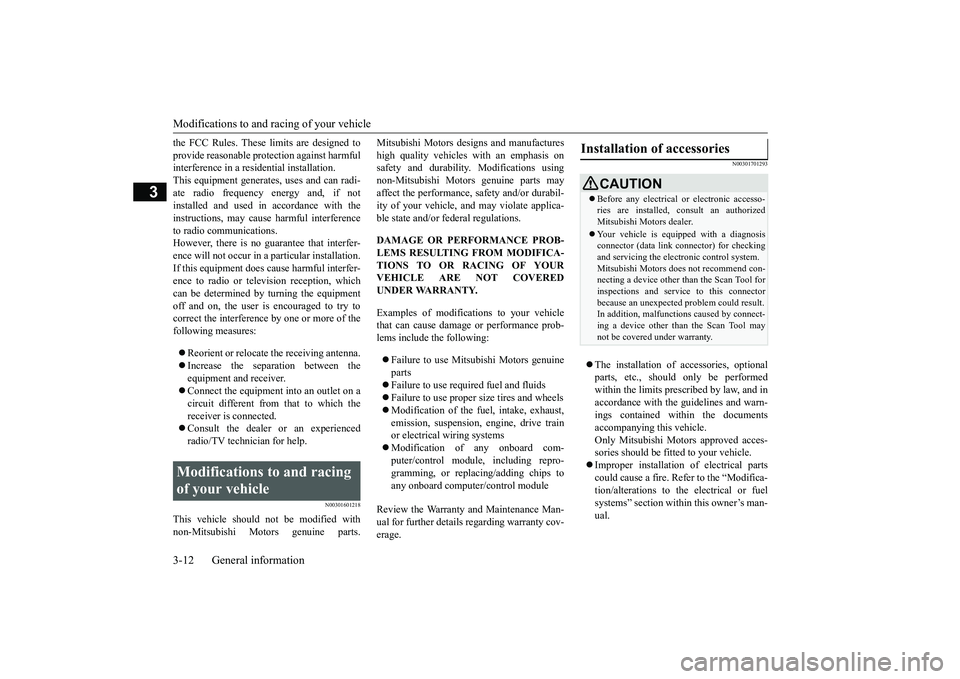
Modifications to and racing of your vehicle 3-12 General information
3
the FCC Rules. These limits are designed to provide reasonable protection against harmful interference in a residential installation. This equipment generates, uses and can radi-ate radio frequency energy and, if not installed and used in accordance with the instructions, may cause harmful interferenceto radio communications. However, there is no guarantee that interfer- ence will not occur in a particular installation.If this equipment does cause harmful interfer-ence to radio or television reception, which can be determined by turning the equipment off and on, the user is encouraged to try tocorrect the interference by one or more of the following measures: Reorient or relocate the receiving antenna. Increase the separation between the equipment and receiver. Connect the equipment into an outlet on a circuit different from that to which thereceiver is connected. Consult the dealer or an experienced radio/TV technician for help.
N00301601218
This vehicle should not be modified withnon-Mitsubishi Motors genuine parts.
Mitsubishi Motors designs and manufactures high quality vehicles with an emphasis on safety and durability. Modifications using non-Mitsubishi Motors genuine parts mayaffect the performance, safety and/or durabil- ity of your vehicle, and may violate applica- ble state and/or federal regulations. DAMAGE OR PERFORMANCE PROB- LEMS RESULTING FROM MODIFICA- TIONS TO OR RACING OF YOUR VEHICLE ARE NOT COVEREDUNDER WARRANTY. Examples of modifications to your vehicle that can cause damage or performance prob- lems include the following: Failure to use Mitsubishi Motors genuine parts Failure to use required fuel and fluids Failure to use proper size tires and wheels Modification of the fuel, intake, exhaust, emission, suspension, engine, drive train or electrical wiring systems Modification of any onboard com- puter/control module, including repro- gramming, or replacing/adding chips to any onboard computer/control module
Review the Warranty and Maintenance Man- ual for further details regarding warranty cov- erage.
N00301701293
The installation of accessories, optional parts, etc., should only be performed within the limits prescribed by law, and inaccordance with the guidelines and warn- ings contained within the documents accompanying this vehicle.Only Mitsubishi Motors approved acces- sories should be fitted to your vehicle. Improper installation of electrical parts could cause a fire. Refer to the “Modifica- tion/alterations to the electrical or fuel systems” section within this owner’s man-ual.
Modifications to and racing of your vehicle
Installation of accessories
CAUTION Before any electrical or electronic accesso- ries are installed, consult an authorized Mitsubishi Motors dealer. Your vehicle is equipped with a diagnosis connector (data link connector) for checking and servicing the electronic control system.Mitsubishi Motors does not recommend con- necting a device other than the Scan Tool for inspections and service to this connectorbecause an unexpected problem could result. In addition, malfunctions caused by connect- ing a device other than the Scan Tool maynot be covered under warranty.
BK0266800US.bo
ok 12 ページ 2018年6月27日 水曜日 午後5時6分
Page 40 of 423
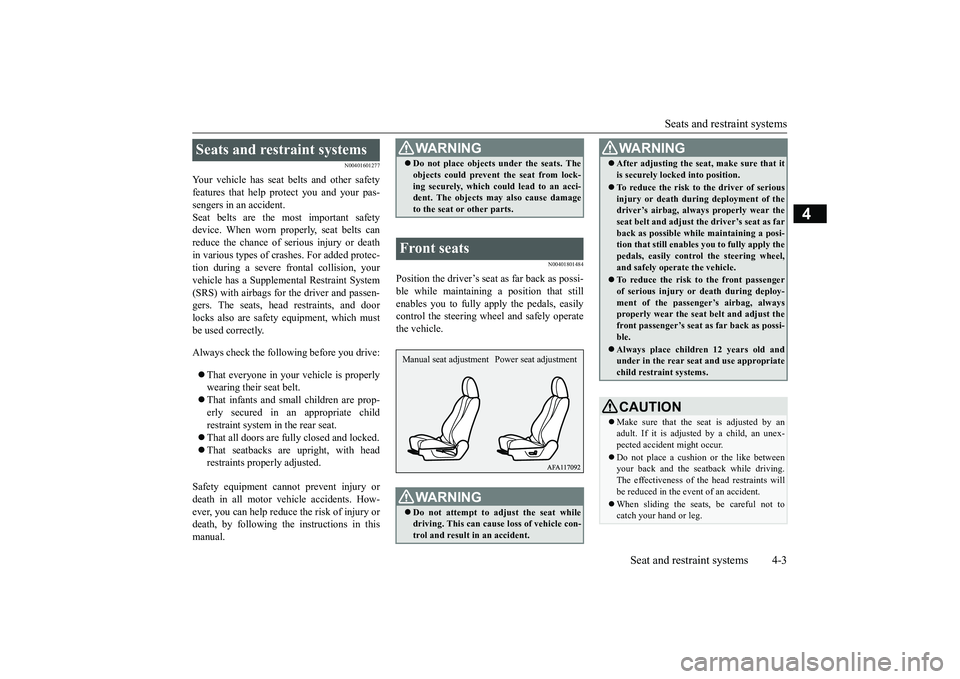
Seats and restraint systems
Seat and restraint systems 4-3
4
N00401601277
Your vehicle has seat belts and other safety features that help protect you and your pas-sengers in an accident. Seat belts are the most important safety device. When worn properly, seat belts canreduce the chance of serious injury or death in various types of crashes. For added protec- tion during a severe frontal collision, yourvehicle has a Supplemental Restraint System(SRS) with airbags for the driver and passen- gers. The seats, head restraints, and door locks also are safety equipment, which mustbe used correctly. Always check the following before you drive: That everyone in your vehicle is properly wearing their seat belt. That infants and small children are prop- erly secured in an appropriate child restraint system in the rear seat. That all doors are fully closed and locked. That seatbacks are upright, with head restraints properly adjusted.
Safety equipment cannot prevent injury or death in all motor vehicle accidents. How-ever, you can help reduce the risk of injury or death, by following the instructions in this manual.
N00401801484
Position the driver’s seat
as far back as possi-
ble while maintaining a position that still enables you to fully apply the pedals, easily control the steering wheel and safely operatethe vehicle.
Seats and restraint systems
WA R N I N G Do not place objects under the seats. The objects could prevent the seat from lock- ing securely, which could lead to an acci- dent. The objects ma
y also cause damage
to the seat or other parts.
Front seats
WA R N I N G Do not attempt to adjust the seat while driving. This can cause loss of vehicle con- trol and result in an accident.Manual seat adjustment Power seat adjustment
After adjusting the seat, make sure that it is securely locked into position. To reduce the risk to the driver of serious injury or death during deployment of thedriver’s airbag, always properly wear the seat belt and adjust th
e driver’s seat as far
back as possible while maintaining a posi-tion that still enables
you to fully apply the
pedals, easily control the steering wheel, and safely operate the vehicle. To reduce the risk to the front passenger of serious injury or death during deploy-ment of the passenger’s airbag, always properly wear the seat belt and adjust the front passenger’s seat as far back as possi-ble. Always place children 12 years old and under in the rear seat and use appropriate child restraint systems.CAUTION Make sure that the seat is adjusted by an adult. If it is adjusted by a child, an unex-pected accident might occur. Do not place a cushion or the like between your back and the seatback while driving. The effectiveness of the head restraints willbe reduced in the event of an accident. When sliding the seats, be careful not to catch your hand or leg.WA R N I N G
BK0266800US.bo
ok 3 ページ 2018年6月27日 水曜日 午後5時6分
Page 42 of 423
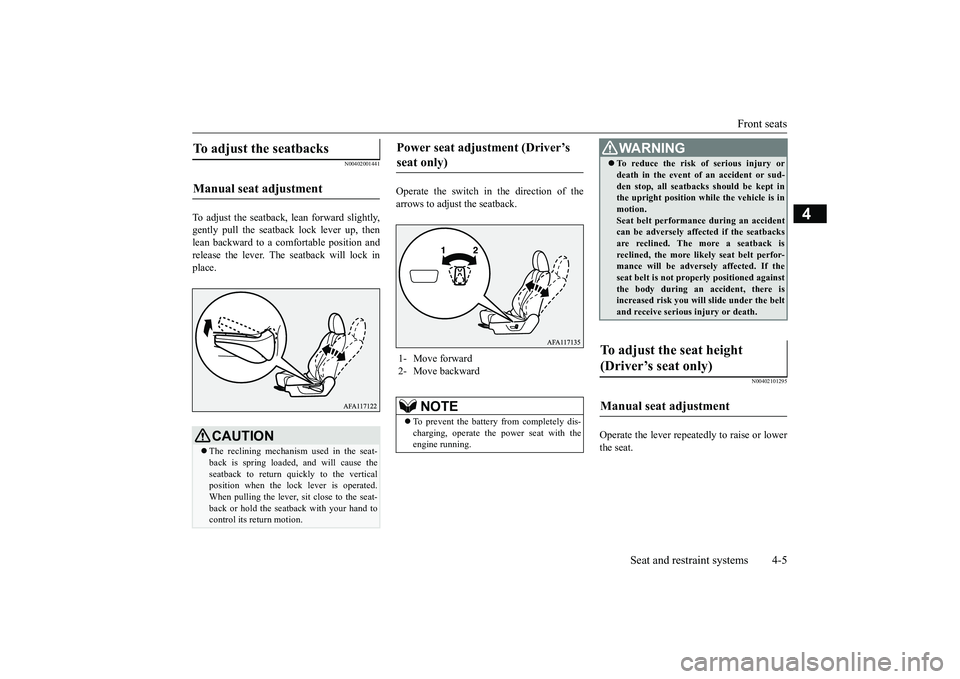
Front seats
Seat and restraint systems 4-5
4
N00402001441
To adjust the seatback, lean forward slightly, gently pull the seatb
ack lock lever up, then
lean backward to a comfortable position and release the lever. The seatback will lock in place.
Operate the switch in the direction of the arrows to adjust the seatback.
N00402101295
Operate the lever repeatedly to raise or lowerthe seat.
To adjust the seatbacks Manual seat adjustment
CAUTION The reclining mechanism used in the seat- back is spring loaded
, and will cause the
seatback to return quickly to the vertical position when the lock lever is operated.When pulling the lever, sit close to the seat- back or hold the seatback with your hand to control its return motion.
Power seat adjustment (Driver’s seat only) 1- Move forward 2- Move backward
NOTE
To prevent the battery from completely dis- charging, operate the power seat with the engine running.
WA R N I N G To reduce the risk of serious injury or death in the event of an accident or sud- den stop, all seatbacks should be kept in the upright position while the vehicle is in motion.Seat belt performance during an accident can be adversely affected if the seatbacks are reclined. The more a seatback isreclined, the more likely seat belt perfor- mance will be adversely affected. If the seat belt is not properly positioned againstthe body during an accident, there is increased risk you will slide under the belt and receive serious injury or death.
To adjust the seat height (Driver’s seat only) Manual seat adjustment
BK0266800US.bo
ok 5 ページ 2018年6月27日 水曜日 午後5時6分
Page 51 of 423
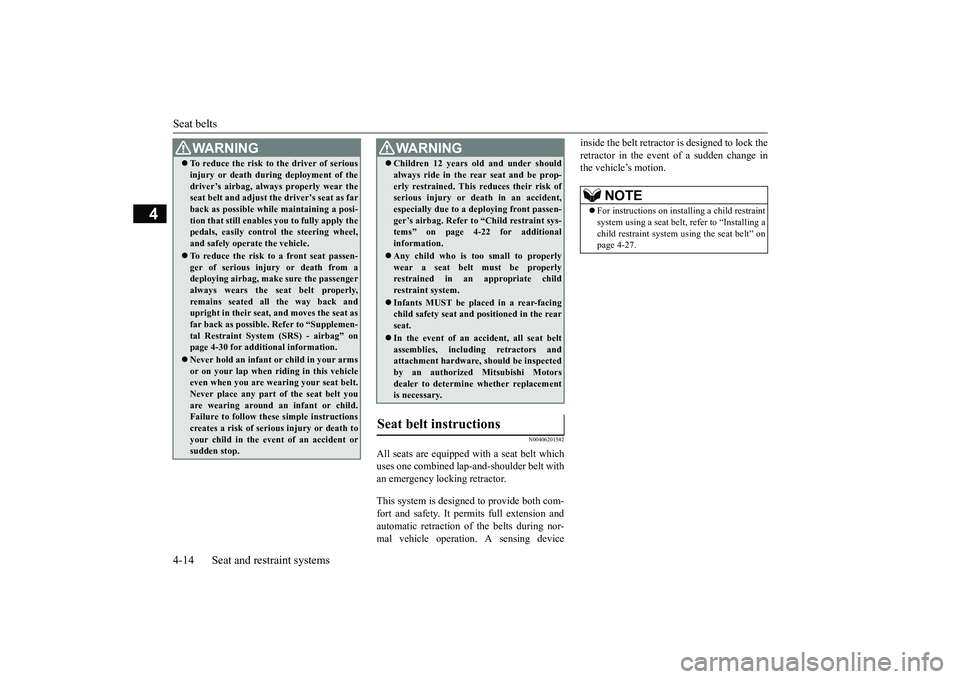
Seat belts 4-14 Seat and restraint systems
4
N00406201542
All seats are equipped with a seat belt which uses one combined lap-and-shoulder belt with an emergency locking retractor. This system is designed to provide both com- fort and safety. It permits full extension and automatic retraction of the belts during nor- mal vehicle operation. A sensing device
inside the belt retractor is designed to lock the retractor in the event of a sudden change in the vehicle’s motion.
To reduce the risk to the driver of serious injury or death during deployment of the driver’s airbag, always properly wear the seat belt and adjust the driver’s seat as far back as possible while maintaining a posi-tion that still enables you to fully apply the pedals, easily control the steering wheel, and safely operate the vehicle. To reduce the risk to a front seat passen- ger of serious injury or death from adeploying airbag, make sure the passenger always wears the seat belt properly, remains seated all the way back andupright in their seat, and moves the seat as far back as possible. Refer to “Supplemen- tal Restraint System (SRS) - airbag” onpage 4-30 for additional information. Never hold an infant or child in your arms or on your lap when riding in this vehicle even when you are wearing your seat belt. Never place any part of the seat belt youare wearing around an infant or child. Failure to follow these simple instructions creates a risk of serious injury or death toyour child in the event of an accident or sudden stop.WA R N I N G
Children 12 years old and under should always ride in the rear seat and be prop- erly restrained. This reduces their risk of serious injury or death in an accident, especially due to a deploying front passen-ger’s airbag. Refer to “Child restraint sys- tems” on page 4-22 for additional information. Any child who is too small to properly wear a seat belt must be properlyrestrained in an appropriate child restraint system. Infants MUST be placed in a rear-facing child safety seat and positioned in the rear seat. In the event of an accident, all seat belt assemblies, including retractors andattachment hardware, should be inspected by an authorized Mitsubishi Motors dealer to determine whether replacementis necessary.
Seat belt instructions
WA R N I N G
NOTE
For instructions on installing a child restraint system using a seat belt, refer to “Installing a child restraint system using the seat belt” on page 4-27.
BK0266800US.bo
ok 14 ページ 2018年6月27日 水曜日 午後5時6分
Page 52 of 423

Seat belts
Seat and restraint systems 4-15
4
1. Occupants should always sit back in their seats with their backs against the upright seatback. To reduce the risk of serious injury or death during deployment of theairbag, adjust the driver’s seat as far back as possible while maintaining a position that still enables you to fully apply thepedals, easily control the steering wheel, and safely operate the vehicle. The front passenger seat should also be moved asfar back as possible. Refer to “Supple-mental Restraint System (SRS) - airbag” on page 4-30. Also refer to “To adjust the seat forward or backward” on page 4-4.
2. Before using the rear center seat belt, make sure that the detachable anchor is securely latched and the seat belt is nottwisted. For details, refer to page 4-17.
3. Grasp the latch plate and slide it up the webbing so that it easily pulls across your body. 4. Pull the seat belt out slowly while holding the latch plate. Push the latch plate into the buckle until you hear a “click”. Pull up on the belt to be sure the latch plate islocked securely in the buckle.
WA R N I N G To reduce the risk of serious injury or death in the event of an accident or sud- den stop, all seatbacks should be kept in the upright position while the vehicle is in motion. Seat belt performance during an accident can be adversely affected if the seatbacksare reclined. The more a seatback is reclined, the more likely seat belt perfor- mance will be adversely affected. If theseat belt is not properly positioned against the body during an accident, there is increased risk you will slide under the beltand receive serious injury or death.
BK0266800US.bo
ok 15 ページ 2018年6月27日 水曜日 午後5時6分